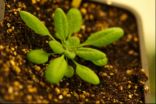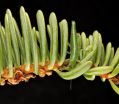(Press-News.org) Zinc is essential for optimal plant growth and development but when high levels of the metal are present in the soil, it can become toxic to the plant. Consequently, plants need to trigger mechanisms capable of coping with that stress. Researchers from the Instituto Gulbenkian de Ciência (IGC) have now discovered a novel genetic mechanism that protects plants from toxic zinc levels. The research team, led by Paula Duque, identified a gene that produces a protein capable of sequestering zinc inside the cells of the root. In the presence of high levels of zinc, this gene undergoes a special processing which ensures more production of the protecting protein. These findings, published in the latest edition of the scientific journal PLOS Genetics*, open new avenues for increasing plant tolerance to zinc.
ZIF2 is the name of the novel gene discovered by Paula Duque's team. By undergoing genetic and cell biology studies in the plant model Arabidopsis thaliana, the researchers found that the ZIF2 gene produces a protein that transports zinc ions into a 'compartment' (the vacuole) of root cells, thus preventing its dispersion to other plant organs. In order to study if the ZIF2 protein was protecting the plant against toxic levels of zinc, plants either lacking ZIF2 or containing increased levels of the protein were generated. The researchers observed that, in the presence of high levels of zinc, plants without ZIF2 were less tolerant to the metal; their roots grew shorter, the production of chlorophyll was impaired, and ultimately the plant's biomass was reduced. Conversely, plants expressing more ZIF2 protein were able to cope better with high levels of zinc; roots grew longer, and more chlorophyll and biomass were produced. These results established that ZIF2 was important for plants to handle toxic zinc levels.
While conducting the genetic studies described above, the research team observed that the ZIF2 gene was producing more than one intermediary molecule of ribonucleic acid (RNA) prior to protein synthesis. When a gene is activated, an RNA molecule that serves as a messenger to translate the genetic information into protein is generated. The appearance of more than one RNA molecule may result from a processing mechanism called alternative splicing that removes different segments from within the RNA, generating molecules with distinct sizes. Therefore, Duque's team set out to investigate whether two ZIF2 RNA molecules played a different role in the plant's protection against zinc. They discovered that, even though both molecules were leading to the production of the same ZIF2 protein, the longer form would result in more protein being produced than the shorter RNA molecule. Intrigued by these results, the researchers investigated the underlying genetic mechanism. They found that the two ZIF2 RNAs arose from an alternative splicing event in a region of the RNA that does not affect the protein 'message' but was nevertheless controlling the production levels of the ZIF2 protein. The research team further discovered that zinc was a trigger for this processing event. In the presence of higher levels of zinc, that region of the RNA molecule was not removed, generating the longer form of the RNA molecule. This would result in more levels of ZIF2 protein produced and consequently confer more plant protection against zinc.
Paula Duque says: "We are amazed with our results. Plants have developed a very 'clever' genetic mechanism that allows them to protect plants from toxic levels of zinc. It is the zinc per se that triggers more production of a protein that then acts to retain this heavy metal in the root of plants, avoiding its toxic effects on leaves, flowers, and other aerial parts of the plant. Why this genetic mechanism occurs we don't know, but we hypothesize that it allows plants to save energy, by only producing more levels of the protein when it is really required."
Estelle Remy, a post-doctoral researcher at Paula Duque's laboratory and first author of this study, adds: "We further observed that the ZIF2 RNA region that undergoes this alternative processing can be used to increase the expression of other proteins. This potentiates our results not only to be used in strategies for crop biofortification, but also for the treatment of soils contaminated with zinc."
INFORMATION:
This study was carried out at the IGC in collaboration with the research groups of Isabel Sá-Correia (Instituto Superior Técnico, Portugal) and of Alekos Athanasiadis (IGC). The research was funded by Fundação para a Ciência e a Tecnologia (FCT, Portugal).
*Remy, E., Cabrito, R. T., Batista, R.A., Hussein, M.A.M., Teixeira, M.C., Athanasiadis, A., Sá-Correia, I., Duque, P. (2014) Intron Retention in the 5'UTR of the Novel ZIF2 Transporter Enhances Translation to Promote Zinc Tolerance in Arabidopsis. PLoS Genet 10(5): e1004375. doi:10.1371/journal.pgen.1004375
http://www.plosgenetics.org/article/info:doi/10.1371/journal.pgen.1004375
Novel genetic mechanism protects plants from toxic zinc
2014-05-16
ELSE PRESS RELEASES FROM THIS DATE:
Tumor cells in the blood may indicate poor prognosis in early breast cancer
2014-05-15
Tumor cells in bone marrow of early breast cancer patients predict a higher risk of relapse as well as poorer survival, but bone marrow biopsy is an invasive and painful procedure. Now, it may be possible to identify tumor cells in a routine blood sample and use them as prognostic markers, according to a study published May 15 in the Journal of the National Cancer Institute.
To assess the prognostic value of circulating tumor cells (CTCs) in patients with early breast cancer, Brigitte Rack, M.D., of the Department of Gynecology and Obstetrics, Klinikum Innenstadt, ...
Older migraine sufferers may have more silent brain injury
2014-05-15
DALLAS, May 15, 2014 — Older migraine sufferers may be more likely to have silent brain injury, according to research published in the American Heart Association’s journal Stroke.
In a new study, people with a history of migraine headaches had double the odds of ischemic silent brain infarction compared to people who said they didn’t have migraines. Silent brain infarction is a brain injury likely caused by a blood clot interrupting blood flow to brain tissue. Sometimes called “silent strokes,” these injuries are symptomless and are a risk factor for future strokes.
Previous ...
Study -- overweight teens more likely to be rejected as friends by normal weight peers
2014-05-15
Tempe, Ariz. (May, 15, 2014) - Overweight young people are more likely to be rejected as friends by peers who are of normal weight, according to new research by Arizona State University social scientists.
"Using Social Network Analysis to Clarify the Role of Obesity in Adolescent Friend Selection," published in the American Journal of Public Health by Arizona State University Associate Professors David R. Schaefer of the School of Human Evolution and Social Change and Sandra D. Simpkins of the T. Denny Sanford School of Social and Family Dynamics, used social network ...
2 JAMA Ophthalmology studies focus on glaucoma medication adherence
2014-05-15
Electronic monitoring to measure medication adherence by patients with glaucoma documented that a sizable number of patients did not regularly use the eye drops prescribed to them.
Topical medications for glaucoma lower intraocular pressure and can delay or slow the progression of the eye disease. Medication adherence is important.
Patients who were treated with once-daily prostaglandin eye drops were recruited from a university-based glaucoma clinic. Patients were given a container with an electronic cap in which to store their eye drops. The cap recorded each ...
NYC safe routes to school program reduces injuries and saves hundreds of millions of dollars
2014-05-15
As Bike to Work week continues, New Yorkers got some good news from a team of researchers at Columbia University's Mailman School of Public Health. Using funds from the federally funded Safe Routes to School program enacted in 2005 in an effort to create safe environments for American children to walk or bike to school, New York City made safety changes to the most dangerous intersections near schools. These interventions included narrowing intersections by building out sidewalks, setting off dedicated bicycle lanes, and installing speed humps, and timing lights so pedestrians ...
Study uncovers new evidence on species evolution
2014-05-15
A study involving Simon Fraser University researchers and published today in the journal Science has found evidence for the genomic basis of how new species evolve, in adapting to different environments.
Researchers studying an insect known as the walking stick (genus Timema) determined that the process of "speciation" happened in association with the use of different host plants. They also determined that across many populations of the insect, those on one host plant are diverging, genetically, from the populations on another host plant, a process they call "parallel ...
Land and power: Women discover one can lead to the other
2014-05-15
The change was clear and it was dramatic: "I went from being property to owning property," a woman in a remote area of Nicaragua told UC Santa Cruz assistant professor of psychology Shelly Grabe.
Grabe wanted to know how the power dynamic between men and women might change when women owned land. More importantly, she wanted to know how the propensity for gender-based violence against women might change.
Writing in the journal Psychology of Women Quarterly, Grabe suggests that when women in developing countries own land, they gain power within their relationships and ...
Caught in the act: Study probes evolution of California insect
2014-05-15
HOUSTON -- (May 15, 2014) -- A first-of-its-kind study this week suggests that the genomes of new species may evolve in a similar, repeatable fashion -- even in cases where populations are evolving in parallel at separate locations. The research is featured on the cover of the May 16 issue of Science.
A team of evolutionary biologists at Rice University, the University of Sheffield and eight other universities used a combination of ecological fieldwork and genomic assays to see how natural selection is playing out across the genome of a Southern California stick insect ...
Marijuana use involved in more fatal accidents in Colorado
2014-05-15
AURORA, Colo. (May 15, 2014) – The proportion of marijuana-positive drivers involved in fatal motor vehicle crashes in Colorado has increased dramatically since the commercialization of medical marijuana in the middle of 2009, according to a study by University of Colorado School of Medicine researchers.
With data from the National Highway Traffic Safety Administration's Fatality Analysis Reporting System covering 1994 to 2011, the researchers analyzed fatal motor vehicle crashes in Colorado and in the 34 states that did not have medical marijuana laws, comparing changes ...
'Physician partners' free doctors to focus on patients, not paperwork
2014-05-15
Primary care physicians already have enough administrative duties on their plates, and the implementation of electronic medical records has only added to their burden. As a result, they have less time to spend with their patients.
But a new UCLA study suggests a simple way to lighten their load: a "physician partner" whose role would be to work on those administrative tasks, such as entering information into patient records, that take up so much of doctors' time. A physician partner allows doctors to focus more of their attention on their patients and leads to greater ...


